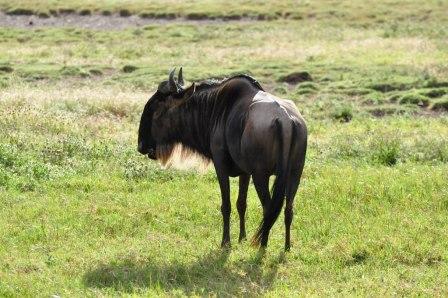WILDEBEEST – Dutch for “wild beast” or “wild cow”
By Chitraparna Sinha

Wilderbeest in the Serengeti
Also known as the ‘gnu’ (gnu belong to the family of Bovidae and includes cattle, goats, antelopes and even-toed horned ungulates), a wildebeest (Connochaetes taurinus) is a hoofed mammal of the antelope family. It looks like a mix of cow and horse.
With the 2 species existing, it is typically a native of Africa:
- Black wildebeest (white-tailed gnu – Connochaetes gnou) – the chocolate brown to black coat is short and glossy in summer and shaggier in winter. There are tufts of long, brush-like blackish hair on the face and a beard on the neck which extends to the chest. A light patch on the nape of the neck is topped by a dark-tipped mane. It has a long, horse-like tail, which is bright white; the eyes are small and beady. The hook-like, smooth horns curve downward, forward and upwards.
- Blue wildebeest (brindled gnu – Connochaetes taurinus) – the color of the coat varies from a deep slate or bluish gray, through light gray to a brown-gray. There are marks of dark brawn, vertical bands on the neck and forequarters. The shoulders are slightly humped with a slight slope in the body towards the rear. The front face is covered with bristly black hair. The mane extends from the horns – over the nape to the shoulders. The tail is black, long and horse-like and a flowing beard is present in both male and female. The horns extend outwards to the side, then curve up and grow slightly inwards.
Profile
A brief profile of the wildebeest is as follows:
- It is about 50 to 58 inches tall.
- Its weight averages between 350 lb and 550 lb.
- Its lifespan is about 20/21 years.
- Its preferred habitat is open grassy plains and open woodlands of southern, central and eastern Africa.
- It is herbivorous.
- Its gestation period is of 8 to 8½ months.
- It is a good target to the cheetahs, lions, hyenas and hunting dogs.
Habitat
With the Serengeti National Park being crowded by groups of this animal, its preferred habitat is open grassy plains and open woodlands of southern, central and eastern Africa.
Food Habits
The main food is grass and it needs its daily quota of water. Still, if water is not available, it can do without it for a few days. Search for fresh grazing forces wildebeest to migrate from Serengeti National Park (around May-June) in Tanzania to Masai Mara (August-September) in Kenya and back to Serengeti (November-January) every year.
Size & Lifespan
A wildebeest is about 50 to 58 inches tall and its weight averages between 350 lb and 550 lb. It can live for about 20/21 years.
Reproduction
The gestation period is 8 to 8½ months and a female produces one calf at one time. The calf stands within minutes of the birth and in a few days, it starts keeping up with the herd.
Predators
A wildebeest is a good target to the cheetahs, lions, hyenas and hunting dogs.
Threat
Human habitations/settlements are driving the wildebeest away from the grasslands.



